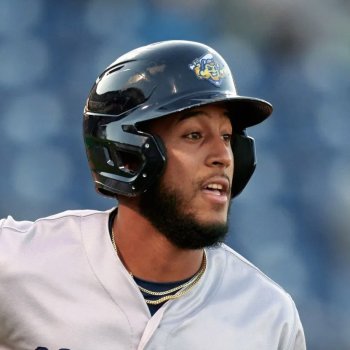All-in for relief: A look back at trades for relievers
Twins Video
Let’s face it, trading for a high-leverage reliever is risky business. Not to mention, it comes with a high price tag.
The trade rumors have swirled for some time in Milwaukee regarding Brewers closer Josh Hader. Earlier in the week, MLB Network discussed a fake trade in which the Minnesota Twins would send Royce Lewis, Ryan Jeffers and Brent Rooker to the Brewers for Hader.
A Hader trade would require quite the return or as an executive told Ken Rosenthal of The Athletic a “bananas price.”
The 2020 trade deadline is Monday and from the Rosenthal report it wouldn’t be surprise to see the Brewers trade some bullpen arms. If the team did in fact trade Hader, who is under team control through 2023, past deadline deals have shown a package of Lewis, Jeffers and Rooker may be bananas but not unrealistic.
If Hader was a rental and set to become a free agent this winter, then Jeffers and Rooker at the very least might still be the asking price for Hader. Just last season the Brewers traded top-10 prospect Mauricio Duban to the San Francisco Giants for Drew Pomeranz and Ray Black. Furthermore, Pomeranz wasn’t a full-time reliever until acquired by the Brewers.
It says a lot about how much value the team with the reliever can get from another. For a player who pitches at most every other day, the risk isn’t always worth it.
Wilson Ramos for Matt Capps
Since 2010, the Twins have made traded for four relievers before the July deadline and have traded one away. Somehow it’s this one that fans talk about the most.
The Twins went for it in 2010 and acquired Capps, a closer who rarely walked anyone, to help with its playoff push. To his credit, Capps allowed six earned runs and struck out 21 in 27 innings as the Twins closer.
Unfortunately for Capps though, the next two seasons were marred with injuries and the lack of strikeout ability caught up to him. Ultimately, both caused his downfall. In 2011 and 2012, Capps allowed 43 earned runs, gave up 15 home runs and struck out just 52 in a combined 95 innings of work.
Ramos had just seven games to his name in the big leagues when the Twins traded him to the Washington Nationals. He was originally thought to be the heir to Joe Mauer. In 2011, Ramos was named to Baseball America Major League All-Rookie Team.
Based on what Ramos has done since the trade and the collapse of Capps, it’s why the trade has such a negative association. Yet, for the 2010 season, it did work.
Chih-Wei Hu for Kevin Jepson
The playoff hopes the Twins had and the aftermath of this trade arguably could be worse than the Capps deal. Jepsen, who had control issues in the past, actually helped the Twins bullpen.
His debut did not go well though.
He walked the first two batters he faced, threw a wild pitch, and then struck out Nelson Cruz. He was replaced after that, but both batters he walked later came around to score in what was a 3-run 11th inning for the Mariners.
OK, first impression aside, Jepsen turned it around. In his next 15 1/3 innings, he struck out 13, walked three, allowed seven hits and no runs.
Altogether, Jepsen was good with the Twins. He kept his walks to a minimum (seven in 28 innings) while opponents were batting .176.
Even though Jepsen wasn’t an elite reliever, the Twins gave up Hu. He started the season ranked 24 in the Twins prospect list and ended the season at 15 in the Rays system.
Despite Jepsen’s performance, which was much better than anticipated, the Twins missed the playoffs. He pitched terrible in 2016, battled injuries, then released in July with a .333 batting average against.
For a pitcher with known control problems, giving up a top-30 prospect stings a little. Especially when the pitcher the Twins traded for didn’t even spend a full calendar year with the team.
Lewin Diaz for Sergio Romo
It would be extremely hard to find someone who wouldn’t pull the trigger on this trade. In hindsight, it still is benefitting the Twins.
Romo gave the Twins bullpen some help in the late innings. He allowed only eight runs in 22 2/3 innings and struck out 27. His attitude, along with how he pitched, is why the Twins resigned for 2020.
Diaz, who was quickly gaining attention in the Twins system, wasn’t ranked in the top-30 to start the season but by season’s end ranked 12 among Marlins prospects.
Again, all in hindsight, this trade seems to have benefitted the Twins. However, they did give up a top-20 prospect for what was at the time, a 36-year-old rental.
Jaylin Davis for Sam Dyson
All things considered, Dyson was having a terrific 2019 with the Giants. Opponents were hitting .213 against him. He was pitching effectively late in games and would have strengthened any team’s bullpen.
The Twins traded three players, the main piece being Davis, to get Dyson. Right away there were issues.
It seemed as though Dyson was pitching hurt and after allowing nine earned runs in 11 1/3 innings, he had surgery.
He hasn’t pitched since.
Davis, on the other hand, didn’t rank in the top-30 prospects with the Giants in 2019. This season he was ranked 13. Kei-Wei Tang, another prospect in the trade, started the season ranked 22.
Chalk this one up as a trade that didn’t go well given the cost to get Dyson and the results of the trade.
What's left to do
As exhausting as it may be to read, or skim, through it all, it takes top-30 prospects to get quality relief pitching before the deadline. It took two top-30 prospects, Jorge Alcala and Gilberto Celestino, for the Houston Astros to land Ryan Pressly in 2018.
Hader is by far one of the best in the game currently and would require a massive return package. The Twins could look for cheaper options. Heck, the Brewers could be a trade partner on that front with left-handed Alex Claudio.
Or the Twins could go a different route and pursue a major league ready, but still a work-in-progress pitcher.
Should the Twins go after a reliever; past trades have shown it takes “more” than what might be perceived to acquire a reliever in the midst of a good season.
The only thing left to determine is if there are bargain deals elsewhere, or the team control of someone like Hader is worth trading away top prospects.





0 Comments
Recommended Comments
There are no comments to display.